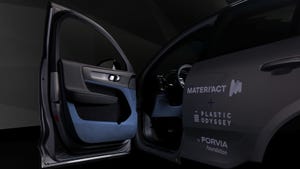A senior executive with the beverage bottling giant spoke this week at the European Bioplastics conference about the company' plans, which include a limited trial in the U.S. and Denmark, replacing up to 30% of each bottle's PET with material sourced from renewable resources. The company initially announced the program earlier this year, as reported here.
November 12, 2009
A senior executive with the beverage bottling giant spoke this week at the European Bioplastics conference about the company' plans, which include a limited trial in the U.S. and Denmark, replacing up to 30% of each bottle's PET with material sourced from renewable resources. The company initially announced the program earlier this year, as reported here.
Cees van Dongen, a member of Coke's global Environment, Health & Safety Council, told the attendees at the annual event, held this year in Berlin, Germany, that the program, set to begin this year in the western U.S. and in Denmark, is the first along a path to greater sustainability. In the U.S. about 30% of the bottles' weight will be made from mono-ethylene glycol (MEG) derived from sugarcane and molasses; in Denmark the percentage of plant-derived MEG will be half that but those bottles will include 50% post-consumer recyclate (PCR). He said there is not enough PCR-PET available in the western U.S. for use in these bottles, as too much of the PET collected in that part of the U.S. is exported to Asia.
MEG and purified terephthalic acid (PTA) are the building blocks of polyethylene terephthalate (PET). Ethanol derived from sugarcane will be fermented to create the bio-MEG, he explained. According to Coke, the Plant bottles will be the first beverage bottles that include content derived from renewable resources and can still be recycled in standard PET recycling streams.
The beverage bottler’s goal is to use 2 billion of the bottles by the end of 2010. In Denmark, Coca-Cola, Coca-Cola Light and Coca-Cola Zero in 500mL and 2L sizes are now available in the PlantBottle packaging. A variety of products, including Coca-Cola, Sprite, Fresca and DASANI, will be available from December 2009 in the bottles in Western Canada. Select markets in the Western United States, including Seattle, San Francisco and Los Angeles, will see the bottles used for sparkling water brands and Dasani Stillwater, in several sizes, starting in January 2010. Future launches are being planned in other markets, including Brazil, Japan and Mexico and for China’s Shanghai Expo in 2010.
According to Dongen, the company's long-term vision is to "grow the business, not the carbon," eventually reaching a net balance of zero waste generated by the company's packaging. Based on total tonnage, about 55% of Coke's packaging is PET, he said. Because PET bottles' design has already been nearly optimized to limit weight, and because the material's manufacture is the most negative aspect of the material from an environmental viewpoint, the best way to limit environmental impact of PET bottles is to replace the PET, he said. The PlantBottles are indistinguishable from standard PET bottles, he said.
However, Dongen said Coke sees little future for the current crop of biodegradable bioplastics as primary beverage packaging. "For the next 5-10 years we don't see biodegradable plastics as an option for our bottles," though the company is looking closely at their use for secondary and tertiary packaging, he said.
Preliminary results from an ongoing independent life cycle analysis (LCA) for the PlantBottles indicate these are more environmentally friendly than standard PET bottles, Dongen said. He allowed, though, that the PlantBottle would not be the best solution for the company in the long run as the bio-ethanol used must be sourced from Brazil. "That's why we're still looking at other bioplastic options," he said, and specifically cited the bottler's work on development of lignocellulosic feedstocks. Lignocellulose gives structure to many plants, including trees, grasses and others not part of the human food chain. Corn stover, switchgrass and wood chips already are being used to make bio-ethanol. The great advantage of this route to MEG would be the availability of raw materials; so far though the process is difficult and expensive.
The goal, Dongen said, is to develop feedstocks suitable for 100% bio-based PET. In a panel discussion later in the conference, he elaborated, saying, "We expect a big wave. We think commodity plastics will be substantially replaced by bioplastics." In light of current bioplastics' already rapid demand growth, he said, "The wave will increase in both height and speed" in the coming years.
What about the price? Dongen would offer no detail on the cost of the bio-MEG but said that Coca-Cola's perception, based on consumer surveys, is that "customers and consumers preference is for bio-materials, and the pricing structure will change to accommodate that." Here again he did not detail plans, saying only that multiple avenues to limit costs were being considered.
About the Author(s)
You May Also Like


